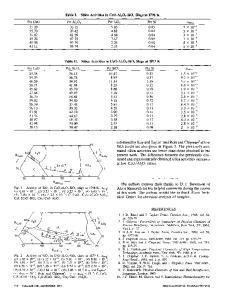Porous calcium aluminate ceramics for bone-graft applications
- PDF / 208,455 Bytes
- 8 Pages / 612 x 792 pts (letter) Page_size
- 39 Downloads / 341 Views
H.L. Hosick School of Molecular Biosciences, Washington State University, Pullman, Washington 99164 (Received 24 April 2002; accepted 20 August 2002)
Calcium aluminate scaffolds with controlled porosity were processed for bone-graft applications. Indirect fused deposition process was used to fabricate these structures. Phase analyses were done using x-ray diffraction technique on powdered samples of calcium aluminates at different compositions. Hg porosimetry was used to determine the pore sizes and the pore volumes present in these controlled porosity structures at different calcium aluminate compositions. Cylindrical samples were tested under uniaxial compressive loading as a function of composition and volume fraction porosity (VFP). Samples of 29% and 44% VFP (designed) with average pore size of 300 m showed compressive strength between 2 and 24 MPa. Cytotoxicity and cell proliferation studies were conducted with a modified human osteoblast cell line (HOB). These materials showed good cell attachment and a steady cell growth behavior with HOB cells during the first three weeks of in vitro analyses.
I. INTRODUCTION
Bioceramics are used for repair and reconstruction of diseased or damaged parts of the musculoskeletal system. Due to their low density, chemical inertness, and compositional similarities with bone, ceramics are generally preferred as bone graft. But the potential of any bioceramics material to be used as an implant depends upon its strength and biocompatibility with the biological environment. Bone is a natural composite of the hydroxyapatite [Ca10(PO4)6(OH)2] ceramic phase, collagen polymer phase, and water. Bones are classified as “compact bone” or cortical bone (low porosity) and “spongy bone” or cancellous bone (high porosity). The cortical bone consists of cylindrical channels (i.e., osteons) that are held together by a framework of hard tissue, mainly hydroxyapatite. Cylindrical fibers of collagen, the major organic component of bone, fill the pores (190–230 m in size) of these bones.1 The inorganic matrix of the cortical bone consists of a porous structure with an interconnected porosity of approximately 65 vol%.2 The spongy bone is the trabecular or cancellous bone that is contained within the cortical shell. The pore sizes in trabecular
a)
Address all correspondence to this author. e-mail: [email protected]
3042
http://journals.cambridge.org
J. Mater. Res., Vol. 17, No. 12, Dec 2002 Downloaded: 10 Jun 2014
bone can vary and are in the range of 100–600 m.2 Trabecular bone has a compressive strength of 0.5– 14.6 MPa,3 whereas the compression strength of cortical bone varies between 100 and 230 MPa. The potential advantage offered by porous ceramic implants is the mechanical stability of the highly convoluted interface that develops when bone grows into the pores of the ceramics. It has been found that porous bone implants with pore size between 100 and 600 m are osteoconductive.4 Low mechanical strength, due to their inherent brittleness, is the only major drawback associated with
Data Loading...










